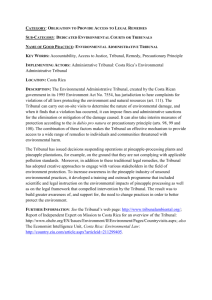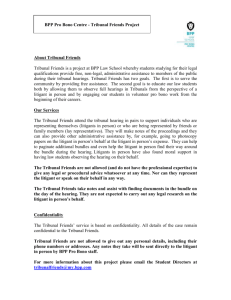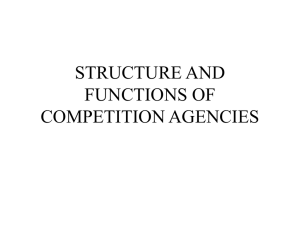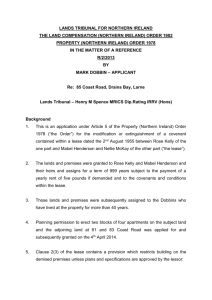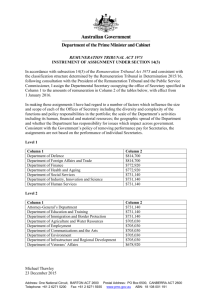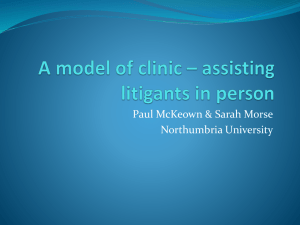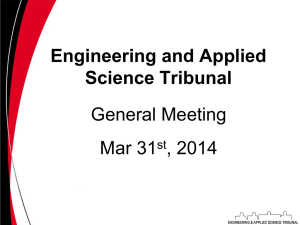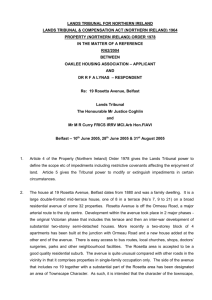lands tribunal for northern ireland - Northern Ireland Court Service
advertisement
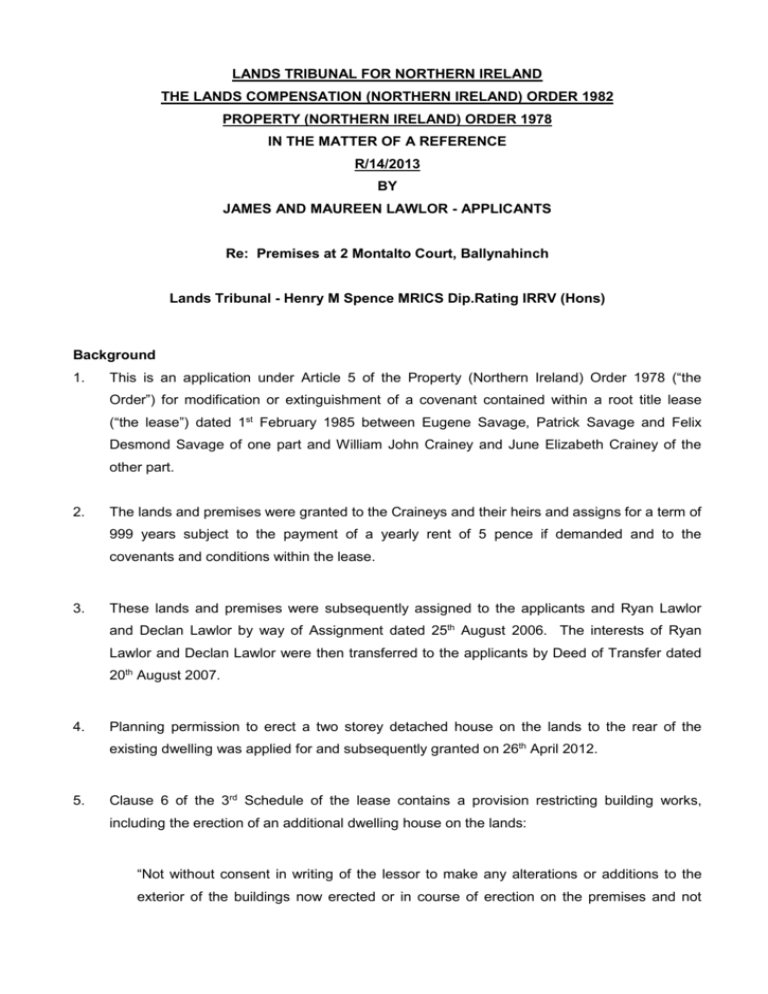
LANDS TRIBUNAL FOR NORTHERN IRELAND THE LANDS COMPENSATION (NORTHERN IRELAND) ORDER 1982 PROPERTY (NORTHERN IRELAND) ORDER 1978 IN THE MATTER OF A REFERENCE R/14/2013 BY JAMES AND MAUREEN LAWLOR - APPLICANTS Re: Premises at 2 Montalto Court, Ballynahinch Lands Tribunal - Henry M Spence MRICS Dip.Rating IRRV (Hons) Background 1. This is an application under Article 5 of the Property (Northern Ireland) Order 1978 (“the Order”) for modification or extinguishment of a covenant contained within a root title lease (“the lease”) dated 1st February 1985 between Eugene Savage, Patrick Savage and Felix Desmond Savage of one part and William John Crainey and June Elizabeth Crainey of the other part. 2. The lands and premises were granted to the Craineys and their heirs and assigns for a term of 999 years subject to the payment of a yearly rent of 5 pence if demanded and to the covenants and conditions within the lease. 3. These lands and premises were subsequently assigned to the applicants and Ryan Lawlor and Declan Lawlor by way of Assignment dated 25th August 2006. The interests of Ryan Lawlor and Declan Lawlor were then transferred to the applicants by Deed of Transfer dated 20th August 2007. 4. Planning permission to erect a two storey detached house on the lands to the rear of the existing dwelling was applied for and subsequently granted on 26th April 2012. 5. Clause 6 of the 3rd Schedule of the lease contains a provision restricting building works, including the erection of an additional dwelling house on the lands: “Not without consent in writing of the lessor to make any alterations or additions to the exterior of the buildings now erected or in course of erection on the premises and not without the like consent to erect or build on any part of the premises and any dwelling house or other erection other that in substitution for the said dwelling house and out offices and to erect and build all additional or substituted buildings or erections in accordance with site plans, elevations and specifications first approved in writing by the lessor”. 6. The applicants wish to develop the lands to erect the additional dwelling house but the lessor has not consented. 7. The applicants therefore seek modification or extinguishment of the covenant in order to permit the erection of the dwelling house in accordance with the granted planning permission. Procedural Matters 8. Mr Tim Warnock BL instructed by Millicent Tate of Murlands, solicitors appeared on behalf of the applicants. Mr Warnock produced: i. documents of title; ii. copy of planning permission of the erection of an additional dwelling; iii. copy of newspaper advertisements; and iv. copies of various pleadings. 9. Mr Ian Milford of H R Douglas & Sons, Chartered Surveyors, Estate Agents, Valuers provided written and oral expert opinion evidence. Mr Milford has been practising in the Ballynahinch area since 1978. 10. The applicants had identified Mr Eugene Savage as the legal beneficiary of the covenant. Mr Savage provided the Tribunal with a written objection and had raised a number of points but he declined to take part in the proceedings. His solicitor advised the Tribunal “please note that the writer shall not be in attendance on Thursday the 5th inst. and our client has not instructed us to brief Counsel”. The Registrar contacted several other interested parties who had come forward but none attended the hearing. Positions 11. Mr Warnock submitted the modification or extinguishment sought was appropriate given that: i. The restriction must be seen in the light of the planning conditions and market trends in 1985 and the change in recent years in the market and in planning conditions to allow for higher density development and in particular development of garden and open spaces adjacent to older extant dwellings. ii. The proposed dwelling is pursuant to granted planning permission, is consistent with the planning conditions, is in keeping with the style of the surrounding properties and would not detrimentally affect the character of the neighbourhood. iii. No material prejudice will be suffered by those owners of surrounding properties and or the landlord. iv. There is no practical benefit to any relevant person to the withholding of consent. v. Even if there is a practical benefit, it is not such to justify the continuation of the restriction in a non-modified form. Statutory Framework 12. The relevant statutory provisions are found in Articles 5(1) and 5(5) of the Property (Northern Ireland) Order 1978. Article 5(1) provides: “The Lands Tribunal, on the application of any person interested in land affected by an impediment, may make an order modifying, or wholly or partially extinguishing, the impediment on being satisfied that the impediment unreasonably impedes the enjoyment of the land or, if not modified or extinguished, would do so.” The word “enjoyment” is defined in the Order as including the “use and development” of the land. 13. Article 5(5) sets out the matters which the Tribunal shall take in to account in determining whether an impediment affecting any land ought to be modified or extinguished. Case Law 14. The Tribunal was referred to the following cases: Re Wickin’s Application (1962) 183 EG 541 CA per Lord Denning MR Jones and Anr v Rhys-Jones (1974) 30 P&CR 451 CA Andrews v Davis [1994] R/17/1993 McGrath v O’Neill [2005] R/41/2004 Kamack v Stinson [2009] R/52/2007 Discussion 15. Consideration of the Article 5(5) issues: a) The period at, the circumstances in, and the purposes for which the impediment was created: The impediment was created by a lease dated 1st February 1985 to provide for market and planning conditions pertaining at that time. Mr Milford gave evidence that in recent years market trends and planning policies had allowed for much higher density development in the locality. The Tribunal agrees. b) Any change in the character of the land or neighbourhood: Since 1985 the Dromore Street/Dromore Road area of Ballynahinch where the subject property is located has expanded considerably. Mr Milford provided detailed evidence of significant changes in the character of the neighbourhood in recent years:i. Clanwilliams Court, a development of smaller detached bungalows built around 1991. ii. Woodridge, a development of much higher density detached properties built around 1995. iii. The Grove, a development of small bungalows mixed with semi-detached housing, built around 2000. iv. Chestnutt Meadows incorporating detached houses mixed with semi-detached and terraced houses built in the early 2000’s v. New apartments constructed 2006/7 and 2013 in the Grove Road and Dromore Street locations. vi. Chestnutt Mews, a development of mixed semi-detached and terraced housing built around 2012. The Tribunal is satisfied that since 1985 the Dromore Street location has become an area of higher density development with varied housing types significantly smaller than those in the Montalto Court development. c) Any public interest in land particularly as exemplified by any development plan adopted under Part III of the Planning (Northern Ireland) Order 1991 for the area in which the land is situated, as that plan is for the time being in force: Planning permission R/2010/0716/F was granted on 26th April 2012. Mr Milford concluded, therefore, that any public interest or planning matters likely to arise in respect of the planning application have been fully explored during the planning process. The Tribunal is satisfied that the development must be in accordance with the development plan given that planning permission has been granted and therefore concludes that the public interest as exemplified by the planning permission would be supported by modification of the covenant. d) Any trend shown by planning permissions (within the meaning of that Planning Order) granted for land in the vicinity of the land, or by refusals of applications for such planning permissions, which are brought to the notice of the Tribunal: Mr Milford has already referenced the planning trends in the locality at “(b)”. Generally there have been trends in recent years to develop garden spaces adjacent to older dwellings. This is consistent with more intense land use and the Tribunal is satisfied that the subject development is in keeping with these trends. e) Whether the impediment secures any practical benefit to any person and, if it does so, the nature and extent of that benefit: Mr Milford testified that in his opinion the impediments do not secure any practical benefit to any person and modification/extinguishment of the covenant is unlikely to affect the surrounding properties. The Tribunal agrees. f) The Tribunal considers this matter to be of no relevance. g) The Tribunal considers this matter to be of no relevance. h) Any other material circumstances: Mr Milford did not submit any further material circumstances. Conclusion 16. The Tribunal is satisfied, having considered the relevant matters and come to the conclusions set out above, that the impediment unreasonably impedes the enjoyment of land or if not modified or extinguished, would do so. 17. The Tribunal therefore orders modification of the covenant to allow for the planning permission or any variation thereof. Compensation 18. The Tribunal has a discretion under Article 5(6) of the Order to direct payment of compensation. 19. Mr Milford submitted that it was most unlikely that there was any reduced consideration at the time of the creation of the covenant which would now warrant the payment of any significant sum of compensation, or that any person entitled to the benefit of the covenant, would suffer any loss or disadvantage as a result of the modification or extinguishment. He considered no compensation should be payable. 20. The Tribunal concludes that it shall not direct payment of any compensation for the following reasons: i. The impediments do not secure any practical benefit. ii. On the balance of probabilities the effect of the covenant, operating as it did to protect the residential character of the immediate locality, was to enhance rather than take away from the value of the property at the time it was imposed. ORDERS ACCORDINGLY 16th September 2013 Henry M Spence MRICS Dip.Rating IRRV (Hons) LANDS TRIBUNAL FOR NORTHERN IRELAND Appearances: Applicants: Mr Tim Warnock BL instructed by Millicent Tate of Murlands, solicitors.

